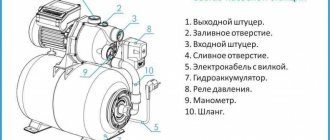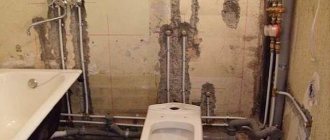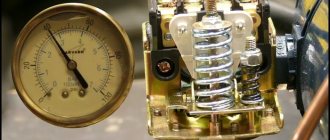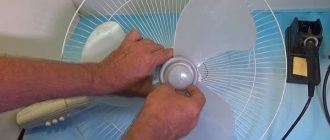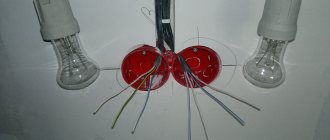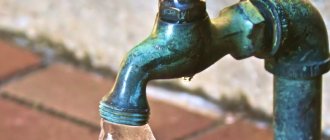Individual water supply for a private house or cottage can be from two sources - a well or a borehole. To automate the supply of water to the house, as well as to create stable pressure, it is necessary to install a pumping station. It consists of a pump, a hydraulic accumulator, a pressure switch and a safety group (pressure gauge and drain valve). The advantage of this idea is that any household appliance can work with such a water supply scheme; another good news is that connecting is not too difficult a task; if you wish, you can install and connect the pumping station with your own hands.
Purpose of pumping stations
Such a station is intended for the functioning of the water supply system of a household, dacha, cottage and maintaining the required pressure in it. Thanks to its operation, it is possible to equip an extensive water supply network, creating conditions for connecting household appliances to it - a washing machine, dishwasher, shower stall, boiler, etc.
According to the installation diagram of the pumping station, it contains a pump, a hydraulic tank, filters, automation and a pipeline structure. The source of life-giving moisture is a well or borehole. In some cases, water intake may be carried out from open reservoirs or other reservoirs.
When installing a pumping station at a dacha is needed to supply water from a pond, lake or river, it can be used exclusively for watering the site or other household needs. Samples of liquid supplied from wells and wells must be taken to a laboratory for analysis - their results will show whether it can be used as drinking water.
Typically, the depth of a well in a personal plot is approximately 20 meters - this is the optimal parameter for placing automatic equipment. This distance allows liquid to be supplied to water collection points without the use of additional devices.
Water supply pumping units operate in cycles consisting of two stages. When the unit is turned on, water rises from the source, fills the system and the hydraulic accumulator. This happens until the pressure reaches the upper limit, after which a special relay turns off the pump and the liquid supply stops.
When you open the taps or operate household appliances that consume water, it flows from the storage tank. The liquid from it is consumed until it reaches the bottom mark. Next, the pump comes back into operation and begins to pump water into the hydraulic tank.
The number of cycles per hour must not be allowed to exceed the permissible number of starts of the pumping equipment being used.
The advantages of installing a water pump in a private home are undeniable:
- Autonomous water supply is provided;
- the efficiency of the water supply system is increased;
- equipment and pipelines are operated in safer conditions;
- it is possible to create a supply of water and, in the event of a lack of power supply, supply it;
- the system maintains a constant pressure and stable liquid pressure;
- the service life of various household appliances connected to the water supply structure increases;
- energy consumption costs are reduced.
In addition, such a station has compact parameters, relatively light weight, and is easy to install.
Types of pumps used
Water supply stations are equipped with several types of pumping equipment:
- Standard surface mounted models. Allows you to supply water from a depth of up to 8-9m.
- Surface, with internal ejector. The internal ejector system allows you to increase the pressure in the system and the suction depth to 10-12m.
- With external ejector. The ejector is lowered to the base of the suction pipe, which increases the water suction depth to 30m. The disadvantage of ejector models is their noise. Therefore, when purchasing such devices, prepare in advance for some discomfort, or take care of soundproofing the room.
- Submersible pumps. The use of submersible types of pumping equipment is advisable for wells with a depth of over 30 m. Such pumps are lowered directly into the well, suspended on cables half a meter from its bottom.
Criterias of choice
When it is planned to install a pumping station in a private house, it is selected so that it fully performs its function, and therefore meets the needs of people who live there permanently or who often come to visit.
Before installing a pumping station in a private house, certain criteria are taken into account:
- Technical features of the equipment.
- Features of the operation of water sources.
Technical indicators
If you plan to install a pumping station for a dacha or household, when choosing it, pay special attention to performance. The best solution would be a design that will provide the required pressure from the well, capable of satisfying the need for water for domestic needs and for a personal plot.
For a comfortable stay outside the city for a family of 4 people, installing a water station of medium or low power is suitable. Typically, such designs are equipped with a hydraulic tank designed for 20 liters. They lift liquid from the well in a volume of 2 - 4 cubic meters per hour and create a pressure of 45 meters or more.
In addition, before installing a pumping station, when purchasing, take into account its dimensions, the water level when the pump is off and running, the type of filter and the cross-section of the pipes.
Lack of water pressure in the system
The weak energy of fluid flow from the sampling points can be explained by certain factors:
- During the adjustment process, the air or water pressure was brought to a minimum value, which is considered unacceptable for the full functioning of the system. In this situation, relay parameters need to be adjusted.
- The pipeline system or working element of the pumping equipment that transmits the energy received from the motor is blocked. The solution to the problem will be to clean the components of the pumping station from dirt.
- Air enters the pipeline. In this case, it is necessary to check all system components for leaks.
Poor quality water supply can be caused by air being drawn in due to lack of density at the joints of water pipes, as well as by low water levels.
Installation diagrams
Before installing a pumping station, you need to choose the optimal location for it.
This takes into account:
- distance from the station to the source;
- humidity and temperature conditions at the pump location;
- availability of space for repairs and maintenance;
- the ability to soundproof the room.
After choosing a location, the water pumping station is installed step by step:
- Work begins with preparation. A solid base with a flat surface made of wood, concrete or brick is created for the transfer pump. You can use a special metal bracket.
- Since the unit begins to vibrate strongly during operation, leaks may appear at the joints of the pipes. Therefore, before connecting the pumping station, a rubber mat or special pads are placed under its supports. Anchor bolts can be used to securely fasten the legs.
- In order to ensure uninterrupted water supply, it is necessary to ensure a constant supply of liquid from the source. It is necessary to follow the instructions on how to properly connect the pumping station to the well, protecting it from freezing. To do this, dig a straight trench in the direction from the source to the foundation of the house to lay pipes in it, preferably with a cross-section of 32 millimeters.
- Pipes are laid below the freezing mark of the ground. When forming a trench, take into account the slope in the direction of water intake. When groundwater lies close to the surface, the pipes are placed above the critical level, but at the same time they are insulated or a heating cable is used.
- When the pipeline is located above the ground, high-quality thermal insulation and heating are required; for this, basalt-based mineral wool can be used.
- Before connecting the pumping station to the water supply, they complete the water intake unit with a surface device and a built-in ejector, connecting polypropylene pipes to the end along with a check valve and a metal mesh, which performs the work of a coarse filter. The check valve ensures stable filling of the pipes with water. To fix it, use a coupling with an external thread. When operating a submersible pump, you only need a pipe and a check valve - it already has a filter of this type.
- The pump weighs a lot, so a strong cable is required to hang it. When lowering the water intake unit of a structure with a surface pump, take into account that the gap between it and the bottom of the well or borehole must be at least 1 meter. For a submersible unit it is 0.5 meters.
- Next, in accordance with the connection diagram of the pumping station, a hydraulic accumulator and a control unit are placed using a five-pin fitting; it is placed in a convenient location in the pressure pipeline. Then a pressure switch and pressure gauge are mounted to it. The storage tank is connected to the side entrance of the fitting.
- All piping elements of the pumping station are complex units, and the breakdown of one of them leads to a malfunction of the water supply system. For this reason, shut-off valves are installed at each site so that it is possible to carry out local repairs by disconnecting a certain part of the structure. This is best done using an American type tap (for more details: “American tap - rules for using fittings for connections”).
- It is advisable to provide in advance the possibility of draining water from the system. Therefore, a branch is made in the pipeline from a tee with a drain valve. A coarse filter is installed on the water supply branch, and a fine filter is installed on the pressure branch.
- Then consumers are connected to the station, the first of them will be the distributing collector.
- The electric motor of the pump is characterized by high power, so a separate power line must be allocated for it. The electrical connection diagram for the pumping station provides for grounding and connection of a voltage stabilizer.
- During the installation process, you need to check the pressure in the air chamber of the accumulator. Its value compared to the switch-on pressure of the unit should be 10% lower. The setting is performed in operating mode. Preliminary values for a tank with a capacity of 20 - 30 liters are 1.4 - 1.7 bar, and for a tank with a volume of 50 - 100 liters 1.7 - 1.9 bar.
- When you install a pumping station with a surface-type product yourself, you need to fill the working part of the system before starting. Unscrew the plugs from the filler hole located at the top of the pump. When the pipeline is equipped with a filler funnel, use it. Water is poured in until it begins to flow out, and then the valve is tightly closed.
- The pump is connected to the power supply during startup. To remove any remaining air that has entered the funnel, open the valve on the pipeline.
- You need to not only know how to properly connect the pumping station, but also how to start it. After turning it on, water should appear from the outlet of the pressure pipeline or a slightly open water tap. When this does not happen, the pump is stopped, water is added and it is started again. After a successful start of the equipment, it is run in and the pressure switch and valve body are adjusted. Most often, adjustment of the pressure switch at the pumping station is performed by a specialist.
Equipment startup
It is not enough to assemble it correctly and connect the station to the water intake point; it is important to ensure that the first launch is successful.
When starting the system for the first time at your dacha, you must follow the following rules:
- It is necessary to tighten the valve tightly after filling the device with water;
- Next, you need to connect the unit to the electrical network, and then remove any remaining air in the system (open the valve slightly);
- During the initial operation of the device, water should flow from the outlet; for this, the pump must run for at least 2 minutes;
- If there is no liquid in the container, turn off the unit and refill the system with water.
Today, stations are often used to organize water supply in the house. Such automatic systems ensure an uninterrupted supply of water. However, the equipment requires periodic cleaning. In addition, it is important to ensure that the location of the device is dry and has good insulation. If these requirements are met, the station will last a long time.
Station assembly
To assemble a pumping station, you need to understand what it is and how it functions.
The station has the following main components:
- a centrifugal pump that pumps out and transports water into the house;
- pressure switch;
- hydraulic tank preventing hydraulic shock;
- an electric motor connected to a relay and a pump;
- pressure gauge for pressure control;
- intake system with check valve;
- line connecting the pump and water intake device.
The installation of these units is carried out in accordance with the water supply diagram of the pumping station of a private house.
The pressure switch regulates its value in the system. When it is below the required parameter, the pump starts, and if it is higher, then it turns off. Using a pressure gauge, the pressure is adjusted. A mandatory element of any water supply station scheme for a home is a hydraulic accumulator. It is sometimes replaced with a storage tank, but this design is considered obsolete.
Preparing the hydraulic accumulator
Before proceeding with direct adjustment of the relay, it is necessary to carry out preparatory work with the storage tank. It is a sealed vessel, inside of which there is a rubber bulb, dividing it into two parts. When water pumped by the pump enters the first, the air pressure increases in the second. The resulting air mass will put pressure on the bulb, thereby maintaining the optimal degree of pressure in the water supply.
For optimal operation of the pumping station, it is necessary to properly organize the air pressure. Since if its value is too high and vice versa, the pump will be started up quite often.
The required parameters in the storage tank are set only after it is completely emptied of liquid. Following the drained water, air is pumped into the accumulator at a rate of 1.4 to 1.7 atmospheres for a container with a volume ranging from twenty to twenty-five liters and from 1.7 to 1.9 atmospheres for larger vessels. Specific values are indicated in the technical data sheet of each pumping station model.
Installation location
Usually the pumping station is assembled in a heated room. The ideal place would be a boiler room with well-equipped sound insulation. There are other options for installing a water supply station. Often it is placed in the basement or basement, but subject to their heat, sound and waterproofing. You can also use a special box - it is placed in the underground with a hatch providing access to the equipment.
A platform is used to place the station in the well. It is installed below the freezing level of the ground. In this case, the structure of the well should be insulated from above. But this method of placing a water station is characterized by problematic access to it.
You can also provide space in the caisson for the pumping station. To do this, a structure is built around the well, buried below the freezing level of the soil. The caisson is closed and thermally insulated at the surface of the earth. For maintenance, a small hatch will be sufficient.
You can also build a house for a pumping station or place equipment in an extension. If this is a separate building, it must not only be insulated, but also heated in cold weather.
Self-installation allows you to significantly reduce the cost of installing a pumping unit. Depending on the type of source, different connection schemes for the water station are used. Correct installation depends, among other things, on small elements such as an oil seal, check valve, filters, etc. They can improve and make the operation of pumping equipment longer.
Setting up and checking automation
After the first start, the automation is adjusted. If the system has a pressure switch, then at maximum values, which are pre-set in the settings, the pump turns off. When water is drawn in, the relay is activated again and starts the system when the pressure becomes minimal. In this case, the settings can be adjusted independently.
Automation setup:
- First you will need to turn off the pump and drain the water from the hydraulic tank. This is easy to do by unscrewing the tap, which is located at the bottom of the system. To open, use a screwdriver or wrench.
- Then the pump starts and water flows into the hydraulic tank.
- In this case, you should monitor the pressure gauge readings when switching off. These are the data that are considered maximum.
- Next, open the tap farthest from the pump. As water flows out, the pressure will decrease, causing it to start. When starting, it is important to record all indicators. They will serve as minimal pressure. Next, find the difference between the indicators.
- When testing the system, you should pay attention to the water pressure that comes from the farthest tap. If the indicators are unsatisfactory, you need to increase the pressure. To do this, turn off the pump and tighten the nut on the large spring located in the relay. To reduce the pressure, the nut is unscrewed.
- Next, proceed to adjusting the pressure differences. The data is obtained by subtracting the maximum from the minimum. The nut in the relay will need to be adjusted to correct the problem of too low or too high pressure. The norm is 1.4 bar.
- After adjustment, functionality is checked. If necessary, you can perform the setup again.
To check the automation of a pumping station, special equipment is used to determine its performance.
In the absence of any relay settings, the adjustment scheme is slightly different. First, the pump starts, building up pressure so that the water pressure from the far end is good. Record the pressure gauge readings and turn off the pump.
When setting the maximum pressure, the indicator should not exceed the limit data for equipment operating under specific conditions.
Next, turn off the power and open the cover on the relay. Then they begin to tighten the nuts. When clicked, the adjustment stops. The cover is put in place and the pump is started. Next, tighten the nut on the smaller spring until it clicks. After checking the functionality, you can safely operate the pumping station.
Expert advice
When, thanks to the operation of the station, an uninterrupted water supply has been established in the household, it must be periodically serviced. First of all, you need to monitor the condition in which the coarse filter is located. If necessary, it must be cleaned.
If this is not done, the performance of the equipment will decrease and water will flow in fits and starts. When the filter is completely clogged, the pump will run idle and then turn off. The frequency of cleaning depends on the amount of impurities present in the water.
It is advisable to check the pressure in the air compartment of the hydraulic tank once a month after installing the water station. The same should be done in case of preservation for the winter, repairs, or downtime. Its value should be 1.2-1.5 atmospheres. If necessary, air is pumped up with a car pump or compressor.
When the station is used exclusively in the warm season, the water must be drained from it before frost sets in.
If all the recommendations on how to correctly install the pumping station specified in the instructions have been followed and the equipment is connected for debugging and determining the pressure at which it will turn off, two liters of water are poured into the receiving device and the unit is started.
When the station turns off, you need to record the fluid pressure. You should also know this parameter when starting the unit automatically. The station may not turn off at a certain liquid pressure. You can deal with this problem using the screws on the pressure switch. They adjust the compression ratio of the springs. To do this, first remove the cover on the device, then tighten the screw with the letters “DR” towards the “plus” or “minus”. To regulate the pressure at which the start will occur automatically, you need to engage the screw marked with the letter “P”.
Common mistakes when starting a station and how to avoid them
A separate room should be equipped for the pumping station.
When starting a pumping station, problems can arise for various reasons. The most common of them are problems with the engine or pump, for example:
- The engine does not start. Check if it is plugged into the outlet. Check fuses, replace if necessary. If the fan impeller does not spin, disconnect the motor from the mains and turn it with a screwdriver.
- The engine is running, but the water is not pumping. The pump may not have been filled with water when starting up. You need to turn off the engine and fill with water.
- The unit works without shutting down. It is possible that the relay is set to a higher upper pressure. Needs to be adjusted.
- The pump turns on and off more than 20 times per hour. Probable cause: the pressure in the accumulator is low, for example, due to damage to the membrane. It is necessary to replace the part and pump up the pressure to normal.
Sometimes problems are easier to prevent than to fix. If you do not preserve the station in the fall and store it in an unheated room in the winter, the remaining unfilled water when frozen can damage important parts of the mechanism or water pipeline, and in the spring you will have to buy a new station or carry out expensive repairs. Therefore, compliance with operating rules will extend the life of the equipment and significantly reduce costs.
